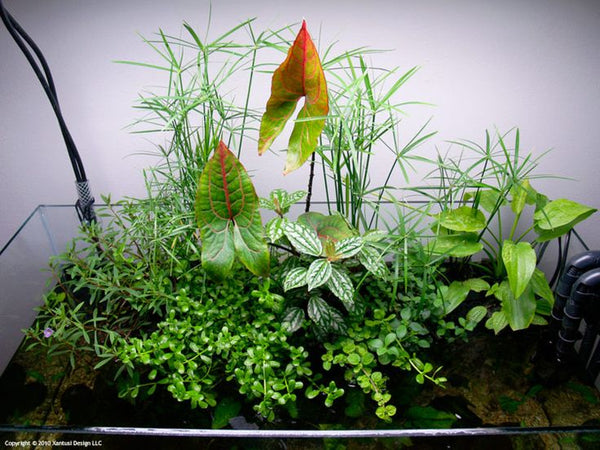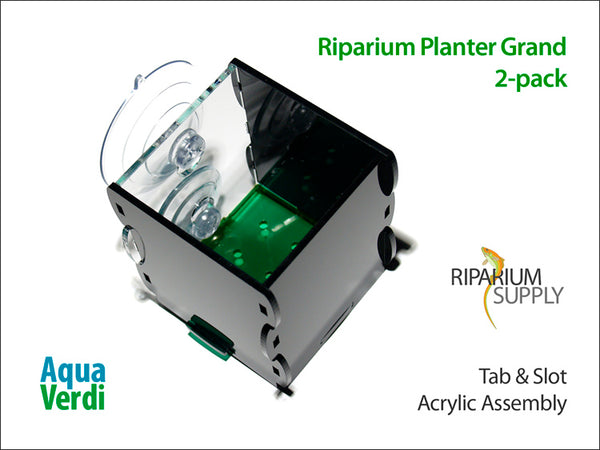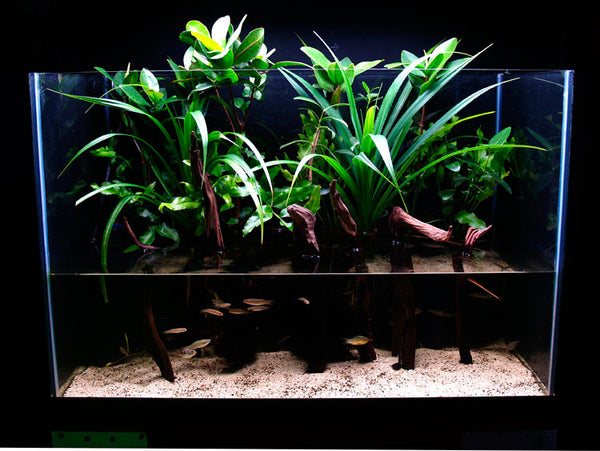News / planted tank
Swamp Tank: Happy Plants in the Riparium Setup at Fish Planet in Deerfield, Illinois
Steve at Fish Planet sent us a few update shots for his showroom riparium planting. The plants look very good and the tank has been a big hit with customers. The following lists basic specifications for this planted model ecosystem:
- Tank - 45-gallon cube (24" X 24") - a great size and shape for a riparium planting
- Lighting - 4X 24", 6,500K HO T5 lamps in pendant fixture, lighting for underwater area supplemented with Finnex I LED strip
- Water circulation/filtration - Eheim 2213 canister supplemented with 100 gph power filter
The robust plant growth above and below water provides lots of natural water purification and habitat structure, allowing for an active fish display with lots of animals. Livestock include Neon Dwarf Rainbows, Silver Hatchetfish, Pygmy Cories and Burmese Rasboras. Among the submerged aquatic plants are various Crypts, Java Fern and Christmas Moss. Riparium plants include Colocasia Dwarf Taro, Ruellia Dwarf Bluebell, Ruellia Tall Bluebell and Acorus Japanese Sweetflag. Notice also the floating leaves of Nymphaea Dwarf Lily.

There is no CO2 injection to enhance underwater plant growth; the tank uses instead a natural approach with the generous fish stocking and bioactive substrates. The riparium plants of course acquire all of the carbon dioxide they need directly from the air, where it is usually much more available than underwater. The submerged plants and riparium plants do benefit with twice-weekly fert dosing for NPK and micronutrients.
We look forward to more updates on this beautiful riparium. It looks as the the Ruellia plant might flower soon with its lovely pink blossoms. That will be a treat!
Neon Dwarf Rainbowfish (Melanotaenia praecox) - an excellent choice for an active fish display in a planted tank.

Colocasia Dwarf Taro with other riparium foliage

The Ruellia Tall Bluebell has numerous flower buds and will bloom soon.

Build a Planted Riparium!
Visit the Aqua Verdi/Riparium Supply site, subscribe to our YouTube channel and watch our Facebook page for tips, new products and design ideas you can use to build a beautiful, relatively easy-care ecosystem display.
The attached photograph shows a Central America/Mexico biotope riparium in a 50-gallon tank. Plants include Acorus Japanese Sweetflag, Acrostichum Leather Fern and Ruellia Dwarf Bluebell.
Use this coupon code in the Aqua Verdi store for a 15% discount on riparium planters and other items in our Dry Goods Collection...
AQUA15

New Riparium Plants - 23 March
We have received a new plant order from one of our suppliers and it includes some really excellent material, including selections that we have not listed in a while and others that are new for our online store.
We have received quite a few inquiries about Acrostichum Leather Fern (1) and we are pleased to have them in stock again. This is a striking swamp fern for larger plantings and can even growing in mildly brackish water. It looks especially good in combination with mangrove trees. It will grow very well in the Riparium Supply, Riparium Planter Grand.
A botanically-interesting species, Anemopsis Yerba Mansa (2) has a range restricted to the Western United States where it grows in sunny, marshy areas. It bears unique foliage and blooms.
Spilanthes Toothache Plant (3) blooms with frequent compound flowers resembling thimbles. This marsh plant from South America grows to just a few inches tall and might be a good choices for nano riparium plantings.
Cyperus Dwarf Umbrella Sedge (4) is a versatile and easy-to-grow riparium plant that works especially well as grassy background foliage repeated in several riparium planters.
Saururus Lizard's Tail (5), a plant relative of Anemopsis Yerba Mansa, is a bushy herbaceous native to Eastern North America. It looks good with many other kinds of riparium plants.
Stay tuned! We'll have more updates on the way for these new plants and more!

New Riparium Planter Design!
Use our latest coupon code for a 15% discount on the new riparium planter design and other dry goods items in the online store...
AQUA15
We are really excited to announce our newest Riparium Supply planted riparium accessory. Offered in our online store as a 2-pack, the Riparium Planter Grand holds almost twice the volume (about 1.5 US cups) of the Riparium Planter Medio and it's an excellent choice for larger riparium plants, such as mangrove trees, Acrostichum danaefolium, pandans and Cyrtosperma johnstonii. Use big plants (24" or taller) for a large riparium setup, or plant a swamp tree in a smaller, shallow tank for an effect resembling the visual balance of a planted bonsai.

Above, red-leaved Cyrtosperma johnstonii as riparium centerpiece plant.

Above, Riparium Supply, Riparium Planter Grand.

Above, brackish riparium with mangrove trees, Pandanus tectorius and Acrostichum danaefolium.
New fish in the mail!
We received some excellent new fish in the mail with an order from the native North American specialty online store, www.ZimmermansFish.com. It's a lot of fun to receive new shipped livestock or plants, and even better when they show up 100% alive as perfect specimens.

These two species will work as centerpieces for a couple of new planted biotope setups representing aquatic ecosystems in the Southern United States. We ordered the bantam sunfish (Lepomis symmetricus) as a group of small adult individuals. This small sunfish (to only ~4") is relatively peaceful and and can be housed in a relatively small enclosure with just a few individuals. Most other Lepomis species are more feisty and should be kept in larger groups to disperse aggression.

The Bantam Sunfish has a rather limited geographic range that includes a few areas in Texas, Louisiana, Kentucky, Tennessee, Missouri and Illinois. We will use the 56-gallon tank that has previously housed a group of species Betta to develop a riparium planting as their habitat biotope. The plant combination will make a few compromises with plants that aren't necessarily from the species' range, but it will create the general appearance of the Bantam Sunfish's densely-vegetated, quiet freshwater habitats: these include river oxbows, swamps, ponds and shallow bays of larger lakes.
Tjhe following link directs to the FishBase.org page for Bantam Sunfish:
FishBase.org: Lepomis symmetricus Forbes, 1883
Japanese Sweetflag (Acorus gramineus) is among the best of riparium plants for recreating a grassy riverbank or lake shore. This plant will fill several of the planters as background foliage, with a few other selections mixed in for variety and biotope representation. Mexican Milkweed (Asclepias curassavica) is an easy to grow riparium plant that might occur in some of the same places as the Bantam Sunfish. We also have a couple seedling specimens of the swamp-dwelling Dwarf Palmetto (Sabal minor), a characteristic Southeast US plant. Tall Bluebell (Ruellia brittoniana) would be another good plant to include.
The older photograph linked below shows a 50-gallon tank planted in this manner as a riparium with Japanese Sweetflag and a few other selections.

While it is an easy grower, Japanese Sweetflag requires a little extra care for planting. It is not a true grass and it grows from a creeping rhizome, similar to the habit of aquarium Anubias plants, that should be positioned right at the substrate surface during planting. The following sequence of photos shows the preferred planting method with the Aqua Verdi Riparium Planter.



In a week or two we will write another post with background information and biotope design ideas for our second new fish species, Redeye Bass (Micropterus coosae). Stay tuned!






